Comm Daily Free 30 Day Trial Offer

We don’t real push commercial services by 3rd parties, but I have nice memories of reading Comm Daily when I worked at FCC and also nice memories of Al Warren the founder and patriarch who I regularly saw in the health club at Lafayette Center when FCC was at 20th and M. Al was a true gentleman and a source of great information on the historical contexts of what was going on in the telecom policy area.
I got an e-mail today offering a free 30 day trial subscription and thought I would share it with readers. I have no financial interest in this offer. (Note that subscriptions to this publication are expensive.)

NAB vs. CTIA: Citigroup Report

[Note: As of 10/7/11 NAB has removed this link to the report from their website. We have asked NAB for an explanation.]
Last week we mentioned how CTIA and NAB were fussing at each other over the relatively minor issue of FM receivers in cell phones. (An issue where this blog has consistently supported the CTIA viewpoint.) But this week the inter trade organization feud has escalated to the big issue: spectrum. With their million dollar CEOs, these 2 goliaths are out for blood to impress their memberships. Now NAB isn’t exactly up to date with the today’s nonbroadcast media. Their Policy Blog’s last entry was July 11 and has only had 5 posts this year! (CTIA’s blog by contrast has almost daily posts and sometimes 2/day.
(NAB’s use of Wordpress’ domain rather than their own domain for the blog is something a web savvy high school student would be embarrassed about. Poor NAB, the obvious Twitter name , @NAB, was already taken by National Australia Bank, but CTIA was able to get @CTIA for themselves. NAB was able to get #NABShow and statements from NAB appear from @NAB Newsroom, and @AirWharton in case your Twitter feed needs more input.)
NAB sent the news media the Citigroup report whose front page is shown above but as of this writing has not said anything on their own website about it. Wireless Week published a post with the eye catching headline: “Citigroup Report Discredits Spectrum Crunch; CTIA Fires Back”. They go on to write,
Citigroup says the U.S. wireless industry isn't facing a spectrum shortage and needs to do a better job managing the bandwidth it already has.
The report claims that wireless operators and other spectrum holders like cable operators are using only a portion of their spectrum to provide wireless services.
Citigroup's analysis was made public by the National Association of Broadcasters, which has been at odds with the wireless industry over an FCC proposal to auction off additional television airwaves for mobile broadband service.
Here are Citigroup”s conclusion (p.27)
•Mixed Signals — Robust Smartphone and tablet sales suggest wireless demand is growing rapidly. And, the FCC suggests the US faces a long-term spectrum shortage. However, several new wireless carriers - Clearwire, LightSquared and Dish - have been slow to light-up their spectrum suggesting excess supply. So, who's right? Isthere a spectrum shortage or not?
•Spectrum Availability High, Use Low — Today, US carriers have 538MHz of spectrum. And, additional 300MHz of additional spectrum waiting in the wings. But, only 192MHz is in use today. And 90% of this in-use spectrum is allocated to 2G, 3G and 3.5G services. As such, we estimate carriers can only offer average wireless speeds of 0.5-1 mbps during the peak busy hour.
•But, Spectrum Is in the Wrong Hands — Too much spectrum is controlled by companies that are not planning on rolling out services or face business and financial challenges. And, larger carriers cannot readily convert a substantial portion of their spectrum to 4G services, because most existing spectrum provides 2G-3.5G services to current users.
•Full 4G Can Deliver 5Mbps — 100% conversion of 538MHz allows carriers to offer 5Mbps with 10% simultaneous usage during peak busy-hour. This speed allows for very robust mobile use and limited home use. However, it is not sufficient for in-home replacement capable of large screen HD video streaming.
•Bottom Lines — We do not believe the US faces a spectrum shortage. However, unless incumbent carriers accelerate their 4G migration plans, or acquire more underutilized spectrum, upstart networks – like Clearwire, LightSquared and Dish – could have a material speed advantage over incumbent carriers provided that they can clear meaningful hurdles for funding and distribution
While NAB has no statement as yet on the report, CTIA certainly does:
“As we have said multiple times in the past, and has been recognized by a bipartisan group of lawmakers in the House and the Senate, the President, and the Chairman of the FCC, there is a need to bring additional spectrum to market to fuel what is one of the country’s key industries. Other countries have recognized the need to fuel their mobile ecosystems and have identified hundreds of megahertz of spectrum for mobile use. Our member companies would not be lining up to spend billions of dollars at auction for the right to use this spectrum if there was not explosive consumer demand for mobile broadband services.
“We need to move past NAB’s efforts to attack what everyone around the world already knows – that mobile broadband usage is exploding, and more spectrum is needed to continue to drive benefits for citizens that even five years ago were unimaginable.
“This time, NAB points to a report to conclude that there is no spectrum shortage. Aside from our concerns with several of the data points in the report, the most amazing element of the report that NAB fails to consider is that the authors of the study INCLUDE 120 MHz of reallocated broadcast spectrum in their analysis, when they talk about spectrum availability being ‘high.’ Page 2 of the report says that an additional 300 MHz of spectrum is ‘waiting in the wings,’ and 120 MHz of which is the very broadcast spectrum that the FCC has proposed to reallocate and that Congress is considering for incentive auctions. CTIA looks forward to working with Congress to ensure that there is in fact sufficient spectrum brought to market.”
And CTIA also has 2 recent tweets proclaiming the need for more mobile spectrum. So while we will not take this opportunity to take sides, it is clear that CTIA is the master of the new media for getting their word out!
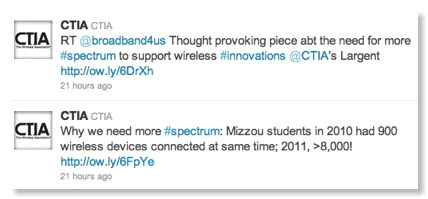
UPDATE
So NAB did not release publicly any comment on the Citigroup report, just posted it on its website although now even that is gone!
However, an e-mail yesterday from NAB revealed their latest actions in this area: a letter from NAB President and CEO Gordon Smith to members of the Joint Select Committee on Deficit Reduction regarding the conclusion of a Citigroup study that there is no spectrum shortage affecting the wireless industry. In addition, an ad regarding the study in Capitol Hill publications.
Here is CTIA’s response released publicly on their website and blog:
"If this is how the NAB is showing their support for voluntary incentive auctions, then I would be fascinated to see how they'd respond if they opposed the idea. Frankly, I would imagine their messaging would look and sound like this letter. To be clear, ALL the proposals on incentive auctions are voluntary.
"Throughout this process, the NAB has consistently misrepresented the facts, with their efforts becoming more desperate as time goes on. The looming spectrum crisis is a fact that has been acknowledged by the president, members of Congress and the FCC Chairman and his colleagues. It has been acknowledged by foreign governments. The only people on the planet who consistently fail to acknowledge its existence work at the NAB.
“The fact is, America’s future is wireless. Consumers want the products and services they want, when they want them. This is a scheme that reflects the wireless broadband model far more closely than it reflects the broadcast television model, which is essentially the same as it was when Philo Farnsworth invented the TV in 1929.
“For the good of our members, American consumers and the American economy, Congress must act this year to make additional spectrum available for wireless broadband services.”
So we can see that CTIA is more transparent about their lobbying while NAB prefers to work in the shadows.
FURTHER UPDATE
CTIA bog post: Citigroup vs. Engineering: I’ll Take Engineering
TPRC 2011 Spectrum Sessions

Below are titles and links to all the spectrum related papers. The whole program is here.
Broadband Metrics: Wireless and Society
Moderator: Katie Shilton, University of Maryland
- Compensating Commercial Carriers for Public Safety Use: Pricing Options and the Financial Benefits and Risks - Ryan Hallahan, Jon Peha - Carnegie Mellon University
- Social Emergency Response Technology Policy - Joe Treglia, Syracuse University, Lee McKnight, Syracuse University, Murali Venkatesh, Syracuse University, Tamal Bose, Virginia Tech, Haris Volos, Virginia Tech, Jan Van Aardt, Rochester Institute of Technology, Don McKeown, Rochester Institute of Technology, Sumita Mishra, Rochester Institute of Technology, Myung Lee, City College of New York
- The Central Role of Wireless in the 21st Century Communications Ecology: Adapting Spectrum and Universal Service Policy to the New Reality - Mark Cooper, Fordham University and University of Colorado
Broadband Adoption: Spectrum Markets
Moderator: Matthew Hussey, The Office of Senator Snowe
- Tradeable Spectrum Interference Rights - Martin B. H. Weiss, Liu Cui - University of Pittsburgh
- Spectrum Aggregation Technology: Benefit-Cost Analysis and Estimation of its Impact on Spectrum Value - Mohammed Alotaibi, Carnegie Mellon University, Marvin A. Sirbu, Carnegie Mellon University
- Incentive Auctions - Coleman Bazelon, Charles Jackson, Giulia McHenry - Brattle Group
Evaluating Broadband Policy 1: Radio Regulations
Moderator: Michael Marcus, Marcus Spectrum Solutions, LLC
- Exclusion Principles and Receiver Boundaries on Spectrum Resources - Sarah Oh, George Mason University
- Wireless Technology Prospects and Policy Options: Results from a National Academies Study - Jon Eisenberg, National Research Council, David Liddle, National Research Council
- A Cross-national Analysis of the Effect of Spectrum Management Policy on the Deployment of 3G Technology - Moinul I. Zaber, Technical University of Lisbon, Marvin Sirbu, Carnegie Mellon University
Broadband, Business and Jobs: Spectrum Sharing
Moderator: Jon Eisenberg, National Academy of Sciences
- The Cost of Knowing: An Economic Evaluation of Context Acquisition in DSA Systems - Martin Weiss, University of Pittsburgh, Mohammed Altamaimi, University of Pittsburgh
- Mobile Broadband Growth, Spectrum Scarcity, and Sustainable Competition - John Chapin, William Lehr, Massachusetts Institute of Technology
- ‘Use it or Share it’: Opening Unused Spectrum Capacity by Building on the TV Bands Database - Michael Calabrese, New America Foundation
CTIA Mum on NTSB Cellphone in Truck Recommendation
To the 50 states and the District of Columbia:
Enact legislation to prohibit cellular telephone use by commercial driver's license holders with a passenger-carrying or school bus endorsement, while driving under the authority of that endorsement, except in emergencies.
In its investigation, NTSB made this finding:
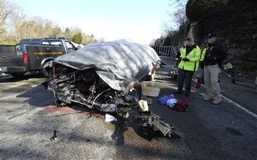
While CTIA recently had plenty of time to make 2 blog posts (1 2) responding to NAB’s latest tirade on the silly FM chip in cellphone issue, more than a week after the NTSB recommendation to ban cell phone use by truckers CTIA remains silent on the issue. (Note that your blogger has repeatedly agreed with CTIA on this relatively minor issue.) Indeed, the CTIA image machine was able to get the first blog post on the FM/cellphone issue out the very same day as NAB’s statement and the second the next day. Both with matching tweets!
The cellular industry does many good things in our society and can be generally proud of its public service record. But the issue of cell phone use in driving is a real public safety issue where CTIA has focused solely on texting and “inexperienced or novice drivers” -- putting it on the other side of the issue from both DOT and NTSB.
Perhaps CTIA feels that if it ignores the NTSB recommendation it will go away. Note that his view is not monolithic in the cellular industry. Sprint continues to be a sponsor of Oprah’s No Phone Zone program.
So, FCC and other CTIA members: Is the marginal revenue gained by ignoring distracted driving and lobbying against regulations to control it really worth it? Does it really have to diminish your other good works?
DOT video on dangers of distracted driving
Video from Oprah on distracted driving
UPDATE
Shortly after this post went up, we heard from CTIA:
Actually, we did have a statement. Here is a statement to attribute to John Walls, vice president of public affairs for CTIA--The Wireless Association:
"Accidents that involve any of the numerous driving distractions are unfortunate, and those resulting in loss of life are tragic. The wireless industry has been educating drivers about the dangers of distracted driving for more than a decade, and does not oppose legislation that restricts the use of wireless communication by drivers."
At the time of the blog post a search of the CTIA website for "NTSB" gave no hits at all. Nor was Mr. Walls' quote available on either the CTIA blog or under press releases. Indeed, a search for the words in the statement had not hits on the CTIA site strongly implying it was not publicly available.
So we welcome this statement that the industry "does not oppose legislation that restricts the use of wireless communication by drivers". However the current CTIA position statement on safe driving does not have Mr. Walls’ general concept of nonopposition to driver restrictions - it only deals with manual texting and “younger drivers”. Let’s hope that CTIA continues to move away from opposing safety-related restrictions and even actually supports the NTSB recommendation.
Gen. Shelton in the News Again on GPS/LightSquared
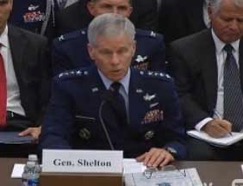
The hearing got off on an odd note with this statement by the committee chair:
That said, I have the unfortunate responsibility to inform the subcommittee that Federal Communications Commission (FCC) Chairman Genachowski refused to appear today. I must also make clear that I consider the Chairman’s failure to show up today to be an affront to the House Armed Services Committee.
Throughout the hearing there was endless ambiguity over whether the GPS receivers possibly threatened by the LightSquared system were military systems or private sector systems. Shelton stated at the hearing:
“Based on the test results and analysis to date, the LightSquared network would effectively jam vital GPS receivers. And to our knowledge thus far, there are no mitigation options that would be effective in eliminating interference to essential GPS services in the United States.”
FoxNews added to the confusion by stating:
The Virginia-based satellite and broadband communications company has plans to build a nationwide, next-generation, 4G phone network that many, including Shelton, think would seriously hinder the effectiveness of high-precision GPS receiver systems, a product used most commonly by the United States military.
A former high level GPS program official recently pointed out to me that the alleged threat to military GPS users is truly bizarre. The proposed terrestrial base stations now are 20 MHz outside the GPS band and are of modest power. A US adversary of even modest means would be capable of building GPS jammers closer to or within the GPS band and with a power much higher than what LightSquared is planning for its terrestrial network.
The Washington Post reported,
“But the new plan, Shelton said, will require billions of dollars in fresh testing of antennas and receivers that could take as long as a decade.”(emphasis added)
Furthermore, such an adversary could also chose a jamming signal more optimized for GPS disruption than the LTE signal proposed by LightSquared. Is this all it takes to disrupt the military’s multibillion dollar critical investment in GPS that is so critical to our national security? If so, there is an urgent problem at hand and it is not just the LightSquared issue, it is the extreme fragility of military GPS systems! More likely, however, is that the proposed system will have no impact on military users but that the whole GPS community is “circling the wagons” in an “all for one, one for all” strategy to protect a few GPS manufacturers who made odd design decisions in their receivers, such as the Deere receiver whose front end covers 3 bands: MSS, GPS, and GLONASS. A strong signal in any of these bands then blocks the receiver.
There was repeated discussion at the hearing of the need for precision GPS receivers to receive “GPS harmonics” for optimal performance. As a service to readers, here is a repeat of the spectrum GPS uses:
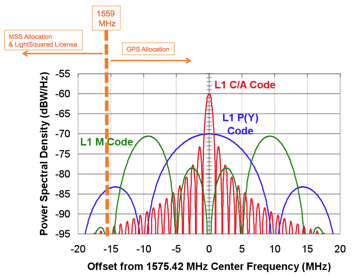
There is some GPS signal power outside the allocated L1 spectrum that ends at 1559 MHz, but not 20 MHz away! At a previous hearing before the House Science Committee, US Geological Survey complained about impact of LightSquared base stations on plate tectonic monitoring receivers. USGS was vague about the bandwidth of this receivers, but it is reported that it is significantly greater than the bandwidth of any usable part of the GPS signal.
Perhaps as indication that the hearing was orchestrated by a PR agency working for commercial GPS interests, it even went into a recent ad by LightSquared in Politico . No mention was made of unreasonable alarmist statements by GPS interests. It became apparent during UWB deliberations that the GPS industry and FAA had a codependency and were willing to do policy favors for each other. Hence FAA took the lead trying to block UWB even though even NTIA readily agreed that none of the UWB emission levels under consideration at the time posed a risk to aviation uses of GPS. Now it looks like Gen. Shelton has slid into the FAA’s former role as defender of GPS commercial interests, this time by blurring the distinction between military uses and commercial uses.
Do we really need this type of codependency?
Prepared Statements
Complete Video of 9/15/11 Hearing
Spectrum Provisions in the Obama "Jobs Bill"

The other spectrum provisions are nowhere as controversial as incentive auctions or the $300+ billion in spending or the tax provisions of the bill so are unlikely to get much attention in the general media. As a service to readers, here is a link to the spectrum provisions of the bill and White House analysis of these provisions.
The part of greatest interest to your blogger is Section 272 – “Clarification of Authorities to Repurpose Federal Spectrum for Commercial Purposes”. Current law allows auction revenues to reimburse federal agencies for relocation costs when they move out of a band to allow nonfederal use of the band. However, in practice the current provisions are too restrictive and lead to valid concerns by federal users and resistance to reallocations. In general costs can only be used for actual relocation to comparable facilities after the auction is completed. This prevents such spending for long range planning costs and purchase of equipment that has long lead times because it must be designed from scratch for a new band.
Here is the White House analysis of these provisions:
Subsections (a) and (b) permit Federal agencies to be fully reimbursed through the Spectrum Relocation Fund (SRF) for relocation costs (including planning costs that occur before an auction), to better enable agencies to evaluate the cost and scheduling implications of relocation activities, and thereby facilitate both an improved auction and relocation process while ensuring the continuity of agency missions. Also, subsection (b) allows for support of costs incurred by Federal agencies to allow shared and unlicensed use of spectrum assigned to agencies.
Subsection (c) permits Federal agencies to be reimbursed for costs incurred in accommodating additional non-Federal access to their frequencies, as well as for studies related to sharing bands among Federal users. Reimbursable costs to enable sharing are consistent with system modifications made in the context of relocation.
In addition, subsection (c) clarifies that the agencies are permitted to acquire state of the art replacement systems under the current-law standard of comparable capability of systems. Section 101(c) also permits agencies to hire term-limited civil servant and contractor support staff to implement relocation projects, and provides further authority for expenditures related to planning in advance of an auction. Subsection (c) furthermore clarifies that the SRF can be used to reimburse agencies for the cost of using commercial services, if these services are the most cost effective way of vacating Federal frequencies while maintaining agency missions. Subsection (d) allows Federal agencies to enter into sharing arrangements with non-Federal entities, upon approval of NTIA and the Office of Management and Budget (OMB).
Subsection (e) provides authority to the Director of OMB to transfer amounts from the SRF for the costs of activities (including planning) directly attributable to relocation of Federal systems. This section also extends the period of funds availability in the SRF from 8 to 15 years, and provides additional flexibility beyond that period upon notification of the Congress. Furthermore, subsection (e) provides that up to 20 percent of the revenue from the auction of licenses associated with frequencies vacated by Federal agencies, or made available through sharing, may be used to enhance agency communications, radar and other spectrum using capabilities; this funding availability for enhancements would be in addition to the relocation costs covered under the current authorities, which provide for maintaining comparable capability for agencies. Use of funds for enhancements, like current authorities for relocation cost reimbursement, would be subject to notification of the appropriate Congressional committees.
In addition to the above mentioned 2 provisions, the bill has the following interesting sections:
- Section 274 – This section would require the FCC to recover a significant portion of the value of new terrestrial broadband deployment rights in certain spectrum frequencies that were originally set aside for satellite services either through competitive bidding procedures or spectrum fee authority. This appears to be aimed at ATC users such as LightSquared.
- Section 277 – This section requires certain spectrum assigned to Federal agencies or in FCC inventories to be identified by NTIA and auctioned by the Commission.
- Section 278 – This section provides the FCC with authority to assess fees for initial spectrum licenses and construction permits that were not assigned by auction and for modifications or renewals of initial licenses and other authorizations, whether granted through competitive bidding or not, based upon public interest principles (for example, if a modification increases the value of a license).
- Section 281 – This section would reallocate the D block for use by first responders and other public safety uses.
- Section 283 – This section would grant the Public Safety Broadband Corporation, created under the bill, the license for the D block of spectrum in addition to certain spectrum held for public safety use by broadband technologies.
- Section 297 – This section establishes the Public Safety Trust Fund with proceeds from certain spectrum auctions. This section provides $7 billion to build and operate the nationwide public safety broadband network as well as conduct research to develop standards for the network.
I will not go into the merits of the provisions in general, but I think the section on federal spectrum and the Spectrum Relocation Fund is a home run and addressees in a pragmatic ways some of the major problems in facilitating sharing and transfer of federal spectrum.
Ten Years After 9-11, Still No Public Safety Network -- Wireless Week

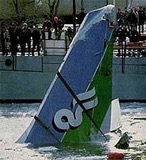

This blog has reported repeatedly on the issue and made suggestions. So you don’t have to hear my viewpoint this time, I strongly recommend a Wireless Week interview with Gregg Riddle, who advocates for public safety workers from his post as president of APCO International, the major trade association in the public safety area. I do not always agree with APCO, but what he says in this interview makes a lot of sense.
Here is a brief excerpt:
WW: How robust are the nation's public safety networks right now? If we had another terrorist attack, would we see the same breakdown in communications we did 10 years ago?
Riddle: It's very possible because we have not addressed the interoperability concern. Public safety operations today are spread out over multiple portions of the spectrum - VHF, UHF, 700 MHz, 800 MHz and low band. They all have their own interoperability capabilities, but when you have public safety utilizing multiple portions of the spectrum, they're not easily interoperable, which was demonstrated on Sept.11, 2001.
Interoperability is critical. It was one of the Sept. 11 Commission's report items that's not been met after 10 years – interoperability for public safety. We're still struggling to meet the goal as described in the report.
There is more than enough blame to go around here both in government entities who played political games and turf battles and corporate interests who wanted to use this situation for market hegemony and their financial benefit. But this is not the time for a postmortem on who has responsibility for this mess. Rather it is the time to remember the spirit of national unity that existed 10 years ago and use it to come up with a consensus solution and adopt it.
Radio Spectrum Institute: A New Source for Spectrum Policy Training
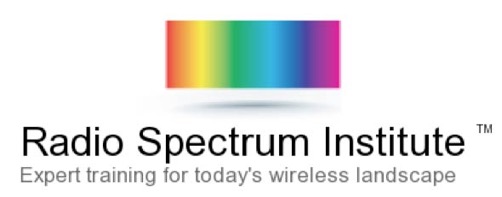
Your blogger has joined forces with four other spectrum policy veterans with experience both inside and outside the key agencies of FCC and NTIA to offer courses on spectrum policy as the Radio Spectrum Institute. The other instructors are Andrew Clegg, Roger LeClair, Nelson Pollack, and Leslie A. Taylor.
The first course, entitled Spectrum Management Boot Camp will be a one day course, given on November 16th in Arlington VA. Spectrum Management Boot Camp combines six Radio Spectrum Institute classes into a complete practical introduction to international and U.S. spectrum management. The emphasis is on the key regulatory aspects that impact the use of the radio spectrum to meet industry or government mission requirements. Important technical considerations are simplified and accessible to the layperson. Spectrum Management Boot Camp is targeted at professionals who must quickly come up to speed on the diverse requirements of modern spectrum management, or current wireless professionals who desire a broader understanding of the radio spectrum management landscape.
For more information, surf over to the RSI website.
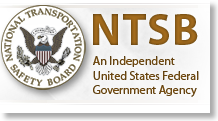





![Validate my RSS feed [Valid RSS]](valid-rss-rogers.png)

